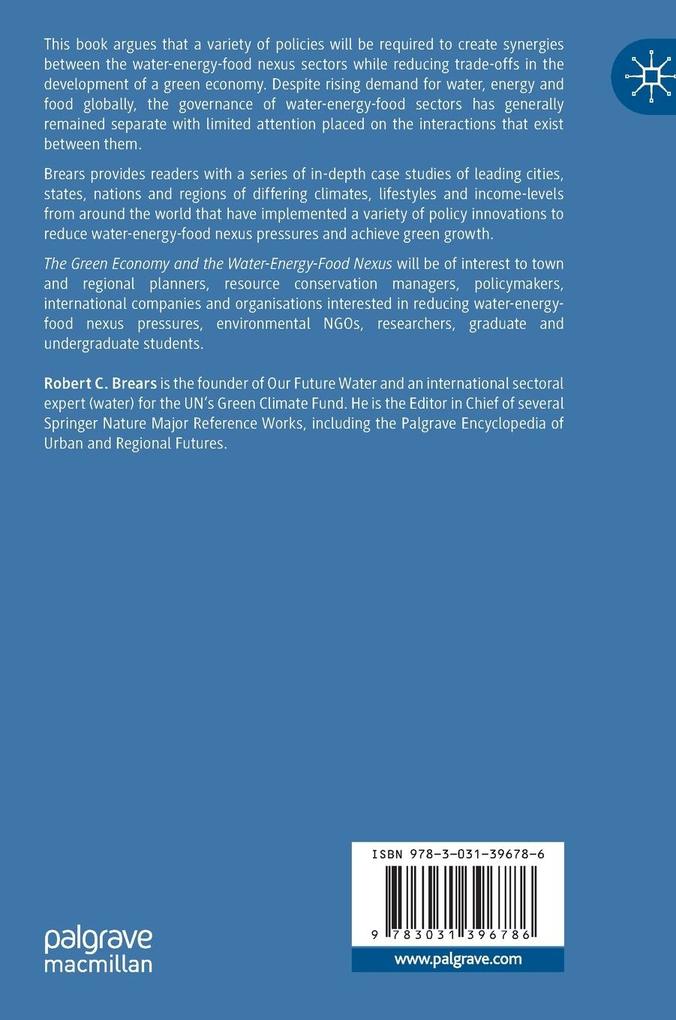
Zustellung: Sa, 14.06. - Mi, 18.06.
Versand in 1-2 Wochen
VersandkostenfreiBestellen & in Filiale abholen:
This book argues that a variety of policies will be required to create synergies between the water-energy-food nexus sectors while reducing trade-offs in the development of a green economy. Despite rising demand for water, energy and food globally, the governance of water-energy-food sectors has generally remained separate with limited attention placed on the interactions that exist between them.
Brears provides readers with a series of in-depth case studies of leading cities, states, nations and regions of differing climates, lifestyles and income-levels from around the world that have implemented a variety of policy innovations to reduce water-energy-food nexus pressures and achieve green growth.
The Green Economy and the Water-Energy-Food Nexus will be of interest to town and regional planners, resource conservation managers, policymakers, international companies and organisations interested in reducing water-energy-food nexus pressures, environmental NGOs, researchers, graduate and undergraduate students.
Brears provides readers with a series of in-depth case studies of leading cities, states, nations and regions of differing climates, lifestyles and income-levels from around the world that have implemented a variety of policy innovations to reduce water-energy-food nexus pressures and achieve green growth.
The Green Economy and the Water-Energy-Food Nexus will be of interest to town and regional planners, resource conservation managers, policymakers, international companies and organisations interested in reducing water-energy-food nexus pressures, environmental NGOs, researchers, graduate and undergraduate students.
Inhaltsverzeichnis
1. introduction. - 2. The Green Economy. - 3. The Green Economy and Sustainable Development. - 4. Policy Tools to Reduce Water-Energy-Food Nexus Pressure. - 5. The Green Economy and the Water-Energy-Food Nexus in New York City. - 6. The Green Economy and the Water-Energy-Food Nexus in Singapore. - 7. The Green Economy and the Water-Energy-Food Nexus in Massachusetts. - 8. The Green Economy and the Water-Energy-Food Nexus in Ontario. - 9. The Green Economy and the Water-Energy-Food Nexus in Denmark. - 10. The Green Economy and the Water-Energy-Food Nexus in Korea. - 11. The Green Economy and the Water-Energy-Food Nexus in the Colorado River Basin. - 12. The Green Economy and the Water-Energy-Food Nexus in the Murray-Darling River. - 13. The Green Economy and the Water-Energy-Food Nexus in the Rhine River Basin. - 14. Best Practices. - 15. Conclusions.
Produktdetails
Erscheinungsdatum
20. September 2023
Sprache
englisch
Auflage
Second Edition 2023
Seitenanzahl
420
Autor/Autorin
Robert C. Brears
Verlag/Hersteller
Produktart
gebunden
Abbildungen
XI, 405 p. 1 illus.
Gewicht
653 g
Größe (L/B/H)
216/153/28 mm
ISBN
9783031396786
Entdecken Sie mehr
Bewertungen
0 Bewertungen
Es wurden noch keine Bewertungen abgegeben. Schreiben Sie die erste Bewertung zu "The Green Economy and the Water-Energy-Food Nexus" und helfen Sie damit anderen bei der Kaufentscheidung.










